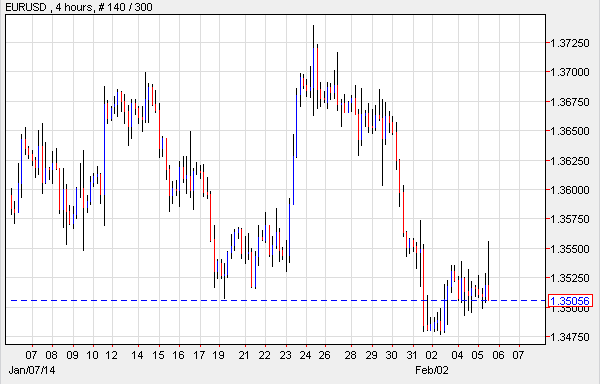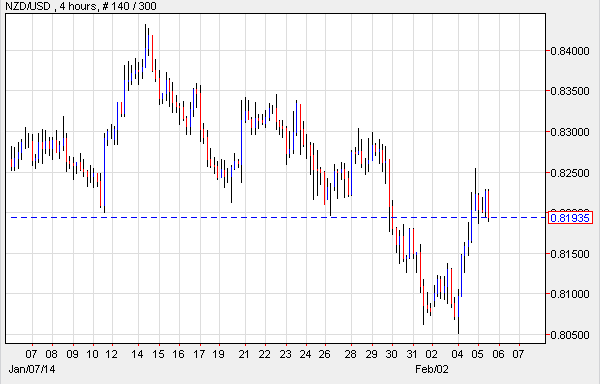The U.S. dollar slumped against the majority of its peers and plunged to an 11-week low against the yen following disappointing economic reports which showed that employers in the Private Sector added fewer workers than predicted in January, raising concerns over the recovery of the labor market. The greenback slipped as the ADP reports showed that Non-Farm Private Payrolls climbed by 175,000, while analysts predicted they would rise by 180,000. Friday’s Non-Farm Payroll Reports, which include some of the most anticipated releases by Forex traders, are expected to denote that more payrolls were created in January, even after rough winter temperatures kept hiring at a low in December. Investors are also keeping an eye on the Federal government, as sources stated that the U.S. could face another government shutdown in the near future. Even though lawmakers approved the budget, some economists have indicated that the U.S. could run out of money in order to meet its obligations if it has no room to borrow more funds. In other news, the U.S. divulged that the Services Purchasing Manager’s Index surged from 55.7 to 56.7 in January, which was higher than estimated. The lackluster U.S. economic metrics helped bolster Gold Prices. The precious metal went up 1.6 percent on Wednesday after announcements confirmed that Non-Farm Private Payrolls climbed less than estimated in the first month of 2014. Futures for April delivery reached $1,274.10 a troy ounce on the New York Mercantile Exchange.
The euro traded slightly below its U.S. peer as releases out of the euro region were mixed. The Service Purchasing Manager’s Indexes from the E.U., Italy and Spain posted high and showed progress for the month of January; however, Retail Sales were disappointing and posted a major decline. The european Central Bank is meeting today in order to discuss the measures that need to be addressed in order to avert the possibility of deflation. euro region inflation indicators have pointed to weakness in inflation, which fell below the central bank’s 2.0 percent target. The British pound fell versus the U.S. dollar despite the weak macroeconomics out of the U.S., but remained under pressure after announcements confirmed that the Services Sector grew at a slower pace than anticipated in January.
The yen advanced versus all of the majors as worries over economic expansion in the U.S. and in the developing economies bolstered demand for harbor currencies. Market traders are concerned about contagion from the emerging markets and have grown weary of the fact that China’s economic slowdown could impact the financial markets. Speculators look forward to February 12th when China will publish data on Exports and Imports.
Lastly, in the South Pacific, the Australian dollar dipped as the Reserve Bank opted for taking a neutral attitude and announced it will leave the cost of borrowing money at 2.50 percent. Economists anticipate that the central bank may adhere to these measures until 2015 as the country could face challenges with an overpriced real estate market and some inflation pressures. The New Zealand dollar weakened versus its U.S. counterpart despite positive news which showed a drop in the Unemployment Rate as well as a bigger number of employed individuals.
EUR/USD: Region Issues Mixed Data
The EUR/USD climbed on encouraging data which showed that the region’s Private Sector sustained growth in January. The Markit Economics release confirmed that the Composite Production Index posted gains and came in at 52.9, up from the 52.1 of the prior month, though lower than the expected 53.2. But the bad news came from retailers who indicated that Retail Sales slumped 1.6 percent. The EUR/USD stayed strong as Spain and Italy announced that their Services PMIs all posted above 50, suggesting that they’re still within expansion territory. Today, the european Central Bank is meeting to discuss the problem of inflation, and may respond with a cut in the costs of borrowing money. Recent reports showed that Manufacturing has improved, as new orders and a hike in exports have boosted output. However, in France and Italy domestic demand remains low.
 EUR/USD 4 Hour Chart" title="EUR/USD 4 Hour Chart" width="474" height="242">
EUR/USD 4 Hour Chart" title="EUR/USD 4 Hour Chart" width="474" height="242">
GBP/USD: Services Slow Down
The GBP/USD dipped on Wednesday as the rate of growth in the U.K.’s Services sector was lower than predicted in the month of January. The pair’s decline came about after Markit Economics announced that the country’s Services activities posted at seven-month lows of 58.3, missing forecasts for the index to post at 59.0. The numbers read slightly lower than those of December (58.8), but economists were not concerned since the release showed that British businesses created more payrolls in January as sentiment turned positive. Analysts now predict that the U.K. could post a solid Gross Domestic Product for the initial quarter of 2014.
 GBP/USD 4 Hour Chart" title="GBP/USD 4 Hour Chart" width="474" height="242">
GBP/USD 4 Hour Chart" title="GBP/USD 4 Hour Chart" width="474" height="242">
EUR/JPY: Pair Slips Ahead Of ECB
The EUR/JPY slumped as investors look ahead to find out what the european Central Bank will do in order to prevent deflation. Many economists anticipate that the central bank may reduce the benchmark interest rate and even lower the deposit rate. Traders bought the yen as risk appetite ebbed following the announcement of weak economic metrics out of the U.S. and as investors remained worried over the situation in the emerging markets and the likelihood of contagion. On the data front, Japan revealed that Average Cash Earnings went up and met economists’ forecasts. And in the euro-zone, the Services PMIs posted positive, though Retail Sales left much to be desired. The EUR/JPY is slated to continue spiraling to the downside until the ECB issues its decision.
 EUR/JPY 4 Hour Chart" title="EUR/JPY 4 Hour Chart" width="474" height="242">
EUR/JPY 4 Hour Chart" title="EUR/JPY 4 Hour Chart" width="474" height="242">
NZD/USD: Unemployment Dips
The NZD/USD extended losses and began its quick decline at the end of last week as the greenback rallied on positive economic fundamentals as well as continued Fed tapering. Meanwhile, in the South Pacific nation, economists are still predicting that the Tasmanian economy will expand in 2014. Gross Domestic Product for instance is forecast to go beyond 3 percent, while it has shown growth in the last ten quarters. The latest data indicates that the rate of Unemployment went down to 6 percent for the first time in close to five years, while 24,000 payrolls were created. The metrics bolstered forecasts the RBNZ may increase the key cash rate. The NZD/USD reversed some of the losses on Monday when the U.S. issued lackluster ISM Manufacturing numbers. And the pair remained supported for some time as the Australian central bank indicated it will not lower the benchmark interest rate for now.
 NZD/USD 4 Hour Chart" title="NZD/USD 4 Hour Chart" width="474" height="242">
NZD/USD 4 Hour Chart" title="NZD/USD 4 Hour Chart" width="474" height="242">
Daily Outlook: Today’s economic calendar shows that Switzerland will report on the Trade Balance. The euro region will issue the Retail PMI and Interest Rate Decision. The U.K. will report on the BOE’s QE Total as well as the Interest Rate Decision. The U.S. will announce Initial and Continuing Jobless Claims, Trade Balance, Non-Farm Productivity and Unit Labor Costs. In Australia, the RBA will release the Monetary Policy Statement. And China will publish the HSBC Services PMI. Furthermore, the ECB President will speak during a Press Conference.
